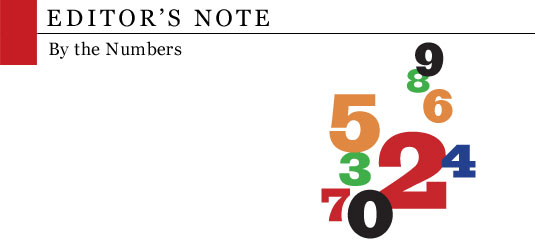
As a society, we are inundated by numbers daily, be it political polls, stock market reports, sales figures, sell-through rates, spreadsheet projections, demographic trends, casualty tolls, betting lines, page views, crime statistics, calorie counts, grade curves, gas prices, economic data…. The list goes on and on, and it seems not a day goes by without some number hitting the newswire to shock and awe us all.
For example: $600 million. If that’s the price tag for the Obamacare web site, it’s no wonder 300 million-plus Americans—including the President—are disgusted, outraged and, let’s be honest, dumbfounded. How can so much be spent on an ineffective site when plenty of people build far more functional ones for peanuts?
Here’s another whopper: $1.8 billion.
That’s the fine the federal government levied against hedge fund billionaire Steven Cohen’s SAC Capital as punishment for the firm’s illegal insider trading scam that ran during the years when his fund outperformed everyone else’s by a mile. It’s just another Madoff-like example of scenarios when investor returns appear way too good to be true. (They usually are.) What makes that fine even more shocking, to me, is the fact that Cohen has amassed a $9 billion personal fortune while cheating. So the fine is really chump change, and talk about sending a message to anyone that cheating does pay incredible dividends. I’ll bet if the Feds dangled a 20-year prison term in front of Cohen he would at least be willing to shell out a few billion more in restitution. Maybe a portion of that could then be used to build an Obamacare web site that actually works. It’s just a suggestion.
Now try wrapping your head around 80 billion. That’s the number of Earth-like habitable planets, give or take a few billion, that astronomers at the University of California, Berkeley and the University of Hawaii, using data from NASA’s Kepler space telescope, estimate are in our Milky Way galaxy alone! With only about seven billion people on Earth, everyone could get their own planet and have a “country house” planet as well with billions more to spare. The fact that the nearest sun-like star with a potential new Earth is a mere 12 light years away, well that’s a number I can digest, theoretically speaking.
Bringing it back to our world, 1774 is the year Birkenstock was founded. The company has endured through revolutions, world wars, the Industrial Age, the space age, the fall of communism, and more. And its cork footbed sandals keep on truckin’. David Kahan, CEO of the brand’s U.S. subsidiary and the subject of this month’s Q&A (p. 14), discusses the company’s recent revolutionary change in corporate direction. The repositioning, Kahan notes, is not solely aimed at maximizing sales amid Birkenstock’s current fashion revival, it’s about putting the company in position for its next 239 years. Compared to the standard five-year business plan, this may seem presumptuous, but, taking into account Birkenstock’s longevity, the odds are not nearly as long as they might sound.
Our latest inductees to the Footwear Plus Style Hall of Fame (p. 21) are two more examples of impressive longevity. Minnetonka’s Thunderbird moccasin, introduced in 1955, has sold millions of pairs worldwide. The Thunderbird has become a summer staple for generations of women who adore its lightweight comfort and versatile Native American styling. The ProWalker by Rockport, another American classic, has sold millions of pairs as well, and it remains a fixture on store shelves nationwide. Considered to be the first-ever fitness walking shoe (introduced in 1985), the style sparked the invention of a category that now accounts for more than $4 billion in sales annually.
I find it reassuring to know that, amid the thousands of new styles that hit the market each season, the potential always exists for one to become the next Thunderbird or ProWalker. It’s like trying to win the lottery, only it’s not a game of chance. Talent, timing and hard work play into capturing the elusive lightning in a bottle. It’s a tireless quest that generates a kinetic energy, helping to propel our industry forward. And of this fact I’m 100 percent certain: It’s only a question of when another iconic style will be born. Of course, having been a working journalist for nearly 25 years, I feel compelled to give full disclosure: My obsession with numbers, percentages, and odds might stem from the fact that I am currently suffering nightmarish elementary school flashbacks while watching my 11-year-old daughter do her fractions homework.




